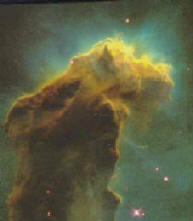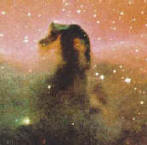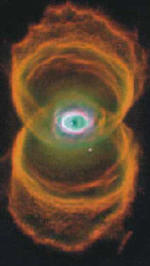






| Website Stats |
Visits from over |
|
Free downloads |
You can now read the material from this website on most electronic devices: -On your computer
Two NEW books from the author of BibleHelp
|
UFO -6: Outer Space is Anything but Empty (Part 6 of 8)
Back

The famous Eagle Nebula
Chapter: 11.12
(Section 11: Understanding God and His Universe)
Copyright © Michael Bronson 1997, 1999, and 2000
BibleHelp.org
Summary
Although we usually think of outer space as being empty, it is actually full of dangerous obstacles. Even if a spaceship only needed to avoid an object once every million miles, it would have to take evasive action once every 6 seconds (traveling at 90% of the speed of light).
Click Here for a book version of this material
We usually think of outer space as being completely empty except for the stars and their accompanying planets. Scientist now realize this is not true. "Empty" space is anything, but empty. Over the past 50 years scientists have found an amazing and complex world out there. The myth of outer space being a total vacuum has been destroyed. Following are just a few of the discoveries:
A Individual atoms: Every cubic yard of outer space has over 700,000 atoms.
B Atomic oxygen: Oxygen, of course, is a very reactive element. Many of our chemical reactions are based on oxygen. Rust is the oxidation of various metals and "fire" is the rapid oxidation of other items.
On Earth, oxygen atoms are normally grouped together in pairs (O2) and in the ozone layer they are normally grouped together in threes (O3). In outer space the oxygen atoms are usually found by themselves. Individual oxygen atoms are called "atomic oxygen."
Atomic oxygen is highly reactive and very unstable. It has an incredibly strong attraction to bond with something else. This is why atomic oxygen is causing problems with our spaceships. For example, after only a week of flying in space, the front edge of the space shuttle’s cargo door has wear spots from atomic oxygen.
The damage from atomic oxygen increases as the speed of impact increases. What do you think would be the damage from atomic oxygen if the space shuttle were traveling at 50% of the speed of light (which would be 20,000 faster than its current speed)? What do you think the damage would be if the space shuttle were traveling for 8.4 years (the time necessary to reach the nearest star traveling at 50% of the speed of light) instead of one week?
The highest concentration of atomic oxygen is found in low earth orbit. This is why satellites in low orbit are damaged quicker by atomic oxygen than satellites in higher orbits. Although we don’t really know for sure, scientists assume that the concentrations of atomic oxygen are even lower outside of our solar system. Let’s say, for the sake of argument, that the concentration of atomic oxygen outside our solar system is 1/1,000th of what the space shuttle encounters. Even in this situation, a trip to our nearest star would still expose the spaceship to 10 million times the amount of atomic oxygen than what the space shuttle encounters. And, since the spaceship is going 20,000 times faster than the space shuttle, the impact of each atom would be much worse.
C Nebulas: The picture at the beginning of the chapter is the famous Eagle Nebula. Our galaxy (like all other galaxies) is full of these beautiful wonders. Nebulas are made up of dust and gases and are billions and sometimes trillions of miles wide. Although most nebulas are dark and hidden from view, some are lit up like giant neon signs.
Nebulas do not generate their own light, but are illuminated by nearby stars. Sometimes the glow of the charged particles produce sharp beautiful colors and sometimes clouds of dust partially block the light and produce muddy and eerie looking monsters (like the picture above). The pictures below show the famous Horsehead Nebula and the Hourglass Nebula.


D Dark Matter: Scientists are mystified by something that is totally invisible. The only reason we know about these mysterious objects is because they are exerting a tremendous gravitational pull on nearby galaxies. These invisible objects (now referred to as "dark matter") are so massive that entire galaxies are orbiting them. Wherever you look in the universe, you’ll see dozens or even hundreds of galaxies orbiting "empty space." Scientists are now saying that the invisible part of the universe is somewhere between 10 to 100 times the size of the visible universe. I won’t go into the complex details, but dark matter is different from the black holes that scientists have been recently talking about.
E Asteroid belts: Most people are unaware that there are two massive asteroid belts orbiting our sun. The first belt is between Mars and Jupiter (separating the solid planets from the giant gas planets) and the second belt (Kuiper Belt) is located a little past Pluto. Some of the debris in Kuiper Belt is as small as grains of sand while some are larger than the planet Pluto. It is felt that this type of debris (although less concentrated) is flying all over the universe.
F Oort’s Cloud: Out past Kuiper Belt lies a spherical cloud of asteroids completely surrounding our solar system. This cloud of debris extends half way out to our nearest star. It is thought that most stars have something similar to our Oort’s Cloud.
Oort’s Cloud is a vast reservoir of sand, dirty snowballs, and boulders. Experts estimate that Oort’s Cloud has over 6 trillion comets that are over several miles across. It should be noted that our knowledge of Oort’s Cloud is very limited and some of the estimates are speculative.
As you can see, outer space holds many hidden dangers for spaceships flying to our nearest star. While it is true that most of these objects are spread apart, they are still lurking in the darkness. More important, the vast distances a spaceship has to travel means there are plenty of objects to run into.
To illustrate, let’s say that there is a spaceship flying to our nearest star and it will only come across an object once every million miles. To put this into prospective, let’s shrink this trip (24.7 trillion miles) down to a trip similar to driving across the U.S. (3,000 miles). In our trip across the U.S., we would have to be avoiding objects in the road every 16 inches. 6.1
Footnotes: The footnote section for the UFO chapters has 10 pages of calculations. I have, therefore, put all of the footnotes and calculations on another web page to keep these web pages cleaner looking. Click on the link below to go to the footnotes:
Other Chapters in this Section
Home
Tell a Friend about this page

